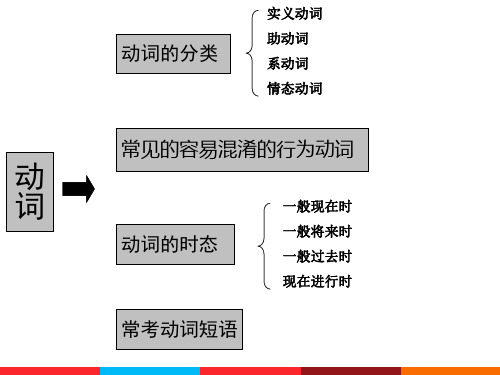最新中考英语专项复习 动词的分类
- 格式:doc
- 大小:149.50 KB
- 文档页数:6



中考动词知识点总结一、动词的分类1.情态动词情态动词是用来表示说话人的情感色彩或者表示说话人对某种行为的看法的动词。
常见的情态动词有can, could, may, might, must, shall, should, will, would等。
情态动词后面跟动词原形,表示主语的能力、许可、可能性、必要性、义务或意向等。
2. 动词的时态动词的时态是表示动作发生的时间的形式。
英语动词的时态有现在时、过去时和将来时,每种时态又可分为简单时、进行时和完成时。
掌握动词的时态对于正确理解英语句子的意思十分重要。
3. 及物动词和不及物动词及物动词是指后面需要接宾语的动词,而不及物动词则是指不需要接宾语的动词。
在中考中,考生需要对及物动词和不及物动词进行正确的使用和区分。
4. 动词的语态动词的语态分为主动语态和被动语态。
主动语态表示主语是动作的执行者,而被动语态则表示主语是动作的承受者。
中考中通常会考查考生对动词语态的正确理解和使用。
5. 不规则动词不规则动词是指在构成其过去分词和过去式时不遵循规则变化的动词。
在中考中,学生需要掌握常见的不规则动词的过去分词和过去式形式,以便正确使用这些动词。
二、动词的用法1. 动词的疑问句在英语的疑问句中,动词需要移至句首才能构成疑问句。
动词在疑问句中的变化和构成方式是中考中的重点考点之一。
2. 动词的否定句在英语的否定句中,需要在动词前加上助动词not来构成否定句。
在中考中,学生需要掌握动词否定句的构成方式,并在实际应用中正确使用。
3. 动词的不定式不定式是动词的一种特殊形式,它可以有自己的主语和宾语,并且可以放在句子的任何位置。
中考会考查学生对不定式的正确使用和理解。
4. 动词的动名词动名词是由动词加上-ing构成的名词形式,它可以充当名词使用。
在中考中,学生需要掌握动名词的构成方式和用法,以便正确使用动名词。
5. 动词的情态动词和助动词情态动词和助动词在句子中的作用是不同的,学生需要掌握情态动词和助动词的用法和区别。

中考英语语法复习:动词的分类中考英语:动词的分类概念:表示动作中状态的词叫做动词。
动词的分类按照在句子中的功能,动词可分为四类:实义动词、系动词、助动词、情态动词。
说明:某些情况下,有些动词既可做实义动词,又可做助动词,例如:We are having a meeting. 我们正在开会。
(having是实义动词。
)He has gone to New York. 他已去纽约。
(has是助动词。
)2. 按照后面是否有宾语,分为两类:及物动词(vt)、不及物动词(vi)。
说明:同一动词有时可用作及物动词,有时可用作不及物动词。
例如:an dance and sing.她能唱歌又能跳舞。
(sing在此用作不及物动词。
)an sing many English songs. 她能唱好多首英文歌曲。
(sing用作及物动词。
) 3. 根据是否受主语的限制,分两类:限定动词、非限定动词。
例如:gs very well. 她唱得很好。
(sing受主语she的限制,故用第三人称单数形式sings.)wants to learn English well. 她想学好英语。
(to learn不受主语she的限制,没有词形变化,是非限定动词。
)说明:英语中共有三种非限定动词,分别是:动词不定式、动名词、分词。
在这里我们多说一下to+动词原型,和ing形式。
英语不同于我们的汉语,不可以两个动词联用。
如,我们汉语说,我喜欢吃苹果。
其中“喜欢”和“吃”是两个动词,汉语这样说没有问题,如果翻译成英语,就变成了“I like eat apple.”这种说法按照英语的规定是不对的。
那怎么办呢,于是就在两个动词之间多了一个“to”,或者把第二个词加上ing.于是就变成了“I lat apple.或者I like eatting apple”这样说来,动词是不是很简单啦!4.根据动词的组成形式,可分为三类:单字词、短语动词、动词短语。

非谓语动词非谓语动词有3种形式:不定式、分词和动名词。
动词不定式动词不定式由“to+动词原形”构成(有时不带to)。
它不能单独作谓语,不随主语的人称和数的变化而变化。
动词不定式连同它的宾语、状语等一起构成不定式短语,不定式短语可在句中作主语、表语、宾语、定语、状语、宾语补足语和主语补足语。
1.动词不定式的句法作用(1)作主语①不定式在句中作主语,相当于名词或代词的作用,谓语动词通常用单数。
●To learn English well is difficult.●To read good books makes him happy.②不定式作主语常常用it作为形式主语,不定式置于句尾。
其句型有3种:1)It + v.+宾语/表语+to do sth.●It is a great honor to give a lecture here.●It is a great pleasure to work with you.●It took me two days to finish the report.●It makes me feel happy to think about my kids.2)It + be +表语+for sb. + to do sth.●It is not easy for her to grasp a foreign language.●It was necessary for him to find out the truth.●It is hard for us to work out the problem.3)It + be +表语+ of +名词/代词+ to do sth.●It is very kind of you to give me a hand.●It was careless of you to leave your bag in the taxi.③“疑问代词/疑问副词/连接词+不定式”结构作主语●How to stop polluting rivers is a big problem.●When and where to hold the meeting is still unknown.(2)作表语①动词不定式直接作表语●The most important thing for him is to take care of his parents.●The only thing we can do is to wait and see.●Our goal is to reach the top of the mountain before 11 a.m..②“how/ what/ when/ where/ which/ why +不定式”结构作表语●The question is how to improve ourselves in English.●The point is when to leave for Hong Kong.●The difficulty is which one to give the reward to.(3)作宾语①动词不定式直接作及物动词的宾语常以动词不定式作宾语的动词由:afford, agree, ask, begin, choose, continue, decide, demand, expect, forget, hate, help, intend, learn, like, mean, need, offer, plan, prepare, prefer, pretend, promise, refuse, remember, require, start, try, volunteer, want, wish等。

中考英语动词分类讲解及练习(有答案)动词综合讲解一、实义动词■①及物动词与不及物动词根据后面是否带宾语,行为动词又可分为及物动词和不及物动词,及物动词。
Vt. vi .They study hard.I know them well.注:有的动词既可作及物动词,也可用作不及物动词。
如:She sings very well.She sang an English song just now.英语里有不少实义动词可以兼作及物动词和不及物动词Shall I begin at once?She began working as a librarian after she left school.When did they leave Chicago?They left last week.短语:■②动态动词和静态动词动态动词表示动作,如give, take, work, run等;静态动词表示感觉、情感、内心世界、相互关系等,如know, exist, be, have, appear, prove, concern, hate, dislike, like, love, surprise, include, depend on, belong to, guess, suppose,imagine, believe, doubt, admire, envy等。
■③延续性动词和非延续性动词根据动作是否延续,行为动词又分为延续性动词和非延续性动词。
如rain, live, work, learn等是延续性动词,go, come, leave, start, arrive, join, finish, end等是非延续性动词。
注:非延续性动词在肯定句中通常不与表示时间段连用的for短语连用。
如:[译]他离开这里三天了。
[误]He has left here for three days.[正]He has been away from here for three days.[正]He left here three days ago.[正]It’s three days since he left.■④限定动词与非限定动词限定动词在句中作谓语,有人称和数的变化。
动词分类及动词短语一,动词分为:助动词,系动词,情态动词和实义动词。
1,助动词:do ,does ,did ,will ,shall ,have ,has ,had ,would ,should等构成各种时态的否疑句的词。
本身无词义。
不能单独做谓语。
和后面的动词一起构成谓语。
2,系动词:系动词亦称连系动词。
本身有词义,不能单独用作谓语,和后边的词一起构成谓语。
1).状态系动词:只有be动词。
如:They are always very happy. 他们总是很高兴。
2).持续系动词:表示主语继续或保持一种状况或态度,主要有keep, remain, stay, rest, lie, stand。
如:I hope you'll keep fit. 我希望你会一直保持健康。
3)表象系动词:表示“看起来好像”,主要有seem, appear(似乎,显露)look。
如:My mother seems very satisfied with my progress.妈妈对我的进步似乎很满意。
4).感官系动词:表示“……起来”,主要有feel(摸起来,感觉),smell(闻起来), sound(听起来), taste(尝起来,吃起来)等。
如:The dish smells delicious. 菜闻起来很香。
5).变化系动词:表示主语变成什么样,主要有become,grow, turn, fall, get, go, 等Eg:He fell ill yesterday. 他昨天病了。
The small town is becoming busier and busier. 小镇变得越来越忙碌。
6).终止系动词:主要有prove, turn out(结果是,证明是)等。
如:My plan turned out a success. 我的计划成功了3,情态动词:表示说话人的语气、情态,无人称和数的变化。
中考英语动词考点分类讲解练习动词是表示动作或状态的词。
动词在句子中充当谓语,用来说明主语是什么或做什么。
一、实义动词实义动词按照其后是否能跟宾语可分为及物动词和不及物动词。
1.及物动词及物动词就是后面必须跟宾语意义才完整的动词。
如love,need,want,have,teach,make等。
I love my mother.我爱我的母亲。
2.不及物动词(1)不及物动词本身意义完整,其后不必跟宾语。
如come,go,run,travel,listen,swim,live,work等。
The man works hard.这个人工作努力。
(2)如果需要带宾语,则不及物动词需要跟适当的介词连用。
Look at the blackboard.看黑板。
3.短语动词l 动词+介词look after照看look for寻找l 动词+副词put up 建立;举起turn on打开l 动词+副词+介词catch up with 赶上do away with 废除l 动词+名词+介词take care of照料;照顾pay attention to注意make use of利用l 动词+名词lose heart失去信心take place 发生【提醒】“动词+副词”形式的短语动词可用作及物或不及物动词。
如果作及物动词,若宾语是名词,可以放在副词之后,也可以放在动词与副词之间。
如果宾语是代词,则必须放在动词与副词之间。
【即学即练】1.—What’s wrong with Simon? He isn’t at school today.—His legs hurt. He was by a motorcycle this morning.A.treatedB.hitC.operatedD.cured2.While traveling in a strange place, you’d better the local people and follow their customs(习俗).A.watchB.changeC.controlD.teach1答案:B2答案:A二、系动词系动词不能单独作谓语,必须与表语一起构成谓语。
动词的分类种类:实义动词,连系动词,助动词,情态动词。
一. 实义动词。
实义动词是能独立作谓语的动词。
按其句法可分为及物动词和不及物动词。
按其持续性可分为延续性动词和非延续性动词。
1.及物动词。
及物动词本身意义不完整,需要接宾语才能使其完整。
1)动词+宾语 we like this book very much.2)动词+宾语+宾补 we call the bird Polly We saw the children play in the parkyesterday注意,带省略to的不定式作宾补的动词,make let have see watch notice hear.3)动词+间接宾语+直接宾语Please pass me the book.常见带双宾语的动词有:give bring buy get leave lend make offer2.不及物动词。
不及物动词自身意思完整,无需接宾语。
如:Horses run fasr. They work in a facory.1)有些动词既可以作及物动词又可以作不及物动词。
如:We study English. We study hard. Boys fly kites. I can fly2)有些及物动词与一些别的词搭配在一起构成短语动词,它的作用等于一个及物动词,要注意积累。
1)动词+介词Look at the blackboard. Listen to me carefully.2)动词+副词He turned off the light when he left He pick it up and give it to me3)动词+副词+介词Let’s go on with the work. He gets along well with his classmates.4)动词+名词+介词He takes pride in doing a job well . please pay attention to the phrarse in the article5)Be+形容词+介词。
动词分类法种类例词按句法作用分类实义动词及物动词play, drive, drink, eat, sing, dance, swim, speak不及物动词go, come, arrive, listen, walk, look助动词do, does, did, will, would, be, have, has情态动词can, could, must, have to, may, might, will, should, shall系动词become, get, turn, look, smell, sound, smell, feel,remain, stay按词汇意义分类动态动词持续性动词read, fly, study, work, grow, improve, increase瞬息性动词jump, knock, begin, leave, die, reach, start, buy 状态动词allow, need, order, prefer, require, ask, mind, advice1.及物动词及物动词后可直接接宾语,可分为跟单宾语的及物动词、双宾语的及物动词、宾语补足语的及物动词。
(1)常见跟单宾语的及物动词:catch, hold, break, celebrate, discuss, educate, grow, borrow, put,forget, love, worry...Eg: Don’t break the rules.We are going to discuss the topic in groups.I borrow a pen from a stranger.Put the bananas in the blender.(2)间接宾语前可加to或for的及物动词: give, offer, buy, pass, sell, show, read, sing, draw,make, choose, cook...Eg: My father bought a bike for me as a present.Miss Li offered some pictures to us.(3)间接宾语一定要放在直接宾语前的及物动词: ask, cost...Eg: The doctor asked me some questions.It costs me twenty dollars.(4)常见跟宾语补足语的及物动词①名词作宾语补足语:call, consider, name, make...Eg: Robinson named the man Friday.②形容词作宾语补足语: make, find, believe, keep...Eg: A sad movie makes me unhappy.③分词作宾语补足语: see, watch, find, keep, feel, hear, make,have...Eg: I love to watch the monkeys climbing around.Lily has her hair cut.④带to的不定式作宾语补足语: advice, tell, ask, expect, promise, want, invite, allow, encourage, remind, require...Eg: My parents required me to clean my room.They invited Mr. Black to take part in the game.⑤不带to的不定式作宾语补足语: feel, hear, make, have, let, see, watch...Eg: I saw him walk into the hall.The funny movie makes people laugh.2.不及物动词不及物动词不能直接跟宾语,大多数动词既是及物动词又是不及物动词,纯不及物动词很少,常见纯不及物动词有:arrive, come, go, walk, sit, stand, happen, lie, run...Eg: We arrived at the science museum at 8:30 this morning.The police happened to know the truth.3.助动词助动词本身没有意义,不能单独作谓语,只能用来帮助主动词构成各种时态、语态、否定式和疑问式等。